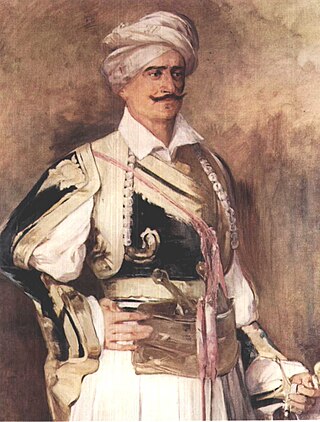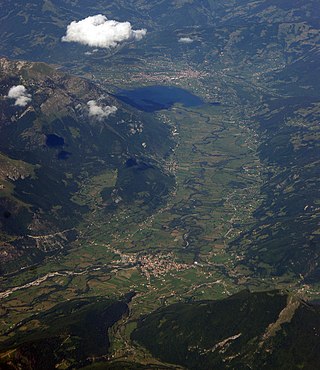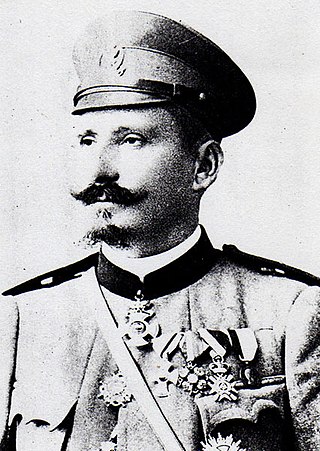
Vasos Mavrovouniotis, born as Vaso Brajović, was a Montenegrin general who played a significant role in the Greek revolution against the Ottoman Empire in 1821.

Kuči is a tribe of Albanian origin, historically located in modern central and eastern Montenegro, north-east of Podgorica, extending along the border with Albania. Processes of Slavicisation during the Ottoman era and onwards facilitated ethno-linguistic shifts within much of the community. As such, people from the Kuči today largely identify themselves as Montenegrins and Serbs, with a minority still identifying as Albanians. In other areas such as the Sandžak, many Muslim descendants of the Kuči today identify as Bosniaks.

Baca Kurti Gjokaj was an Albanian leader who participated in the Battle of Ržanica against the Principality of Montenegro.
Jovan Radonjić, commonly known as Jovo (Јово) or Joko, was the guvernadur of Montenegro between 1764 and 1803.
Baldovin was a Serbian knez (duke) and kaznac that served King Stefan Uroš III. He held the province around Vranje.

Musa Kesedžija, Musa Arbanas, also described as Musa the Robber, Musa the Outlaw, Musa the Highwayman or Musa the Beheader, is a popular legendary villain of Serbian epic poetry and Bulgarian and Macedonian folklore. He is most famous as a rival of Prince Marko, a hero of Serbian and South Slavic folklore.

The Dobrilovina Monastery is a Serbian Orthodox monastery in Donja Dobrilovina, Mojkovac, northern Montenegro. It is located on the left Tara river banks, in a region known as Potarje, at the beginning of the Tara River Canyon, the deepest river canyon in Europe. The village of Dobrihnina was mentioned in a Nemanjić charter in 1253, though the oldest preserved mention of the monastery dates back to 1592, when the Ottoman authorities allowed the locals to rebuild their monastery in Dobrilovina. In 1609, the current standing church dedicated to St. George was finished; the frescoes were finished by 1613. This church has been pillaged, abandoned, destroyed and renovated several times since its founding.
Brda refers to a historical and ethnographical region in Montenegro. The Brda are one of the country's four historic tribal regions, along with Old Montenegro, Old Herzegovina and the Montenegrin Littoral. The historical tribes of the Brda are the Vasojevići, the Bjelopavlići, the Piperi, the Kuči, the Bratonožići, the Moračani and the Rovčani. Collectively known as "the seven tribes" or "the seven hills", they were referred to as "Highlander tribes" before their gradual integration into Montenegro, from the late 18th to the early 20th century. As a result, members of these tribes are also often called "Highlanders".
The Battle of Novšiće was a battle for control over Plav and Gusinje fought on 4 December 1879 between forces of the Principality of Montenegro led by Marko Miljanov and local pro-Ottoman forces which included irregulars of the League of Prizren, both commanded by Ali Pasha, the Kaymekam of Gusinje. The League of Prizren consisted mainly of Albanians from Plav and Gusinje in Scutari Vilayet and irregulars from Kosovo Vilayet.

Çun Mula was the bajraktar ("flag-bearer") of the Hoti tribe and an Albanian freedom fighter. His family, the Lucgjonaj, descended from the Junçaj family of Hoti. According to the Code of Lekë Dukagjini, Çun Mula's family was put in charge of the Malësia tribes, leading them bravely and faithfully in the many wars against Montenegrin and Ottoman forces.
The Velika attacks were a series of attacks during the Congress of Berlin, carried out by Albanian irregulars.
Grdan was the vojvoda (duke) of the Nikšić nahija, part of the Sanjak of Herzegovina, who led several uprisings against the Ottomans in between 1596 and 1612, alongside Serbian Patriarch Jovan Kantul.

The Bratonožići is a historical tribe (pleme) of Albanian origin in the Brda region of Montenegro. It appeared during the Ottoman period and was a captaincy of the Principality of Montenegro in the 19th century. Today, it forms part of northeastern Podgorica Municipality. In Montenegro, the majority of people who trace their origin in Bratonožići identify as Christian Orthodox Montenegrins and Christian Orthodox Serbs. Brotherhoods (bratstvo) from the historical tribe that settled in Bijelo Polje and became Muslims in the Ottoman period identify as Bosniaks. In the 18th century, many families from the region settled in western Serbia. In Kosovo, a part of the Serbs of western Kosovo come from Bratonožići.
Süleyman Pasha was an Albanian Ottoman sanjak-bey of Scutari, a Vizier and a member of the House of Bushati.
On August 6, 1904, there were murders in Kokošinje of Serbs carried out by the IMRO Bulgarian bands of Atanas Babata. Parts of the IMRO, which supported the Bulgarian Exarchate, executed notable Serbs, who supported the Patriarchate of Constantinople.
Silić is a surname found in Bosnia and Herzegovina and Croatia. It may refer to:

The Battles for Plav and Gusinje were armed conflicts between the Principality of Montenegro and the League of Prizren that broke out following the decision of the Congress of Berlin (1878) that the territories of Plav and Gusinje be ceded to Montenegro. The conflicts took place in this territory between 9 October 1879 and 8 January 1880. The following battles were fought:
The First Balkan Alliance was a system of agreements concluded by the Principality of Serbia in the period of 1866–68 to unite the nations of the Balkans in a common struggle against the Ottoman Empire. The plans for forging this alliance were based on the organization of a major general uprising, as opposed to individual uprisings by the various ethnic groups in Ottoman territory. According to the plans, the Albanians would begin the uprising, followed by Serb and Greek volunteers and finally and simultaneously by the regular armies of Serbia and Greece. According to the plans and agreements, after a successful war against the Ottomans, the Balkan nations would establish a united federation.

Radomir Vešović was a Montenegrin and Yugoslav military officer and politician. Vešović was born in village of Lopate in Montenegrin county of Lijeva Rijeka, in a family whose male members were traditionally military officers. He completed military education in Italy in 1890 as the first member of Vasojevići tribe who received formal military education. In 1911 he was appointed as commander of Vasojević brigade, with rank of brigadier.
Avram Cemović nicknamed Avro (1864–1914) was a member of notable Serb family Cemović from Vasojevići who is best known as one of the commanders of rebels against Ottoman Empire in the Lower Vasojevići region and military officer in the Army of Montenegro during the First Balkan War.









